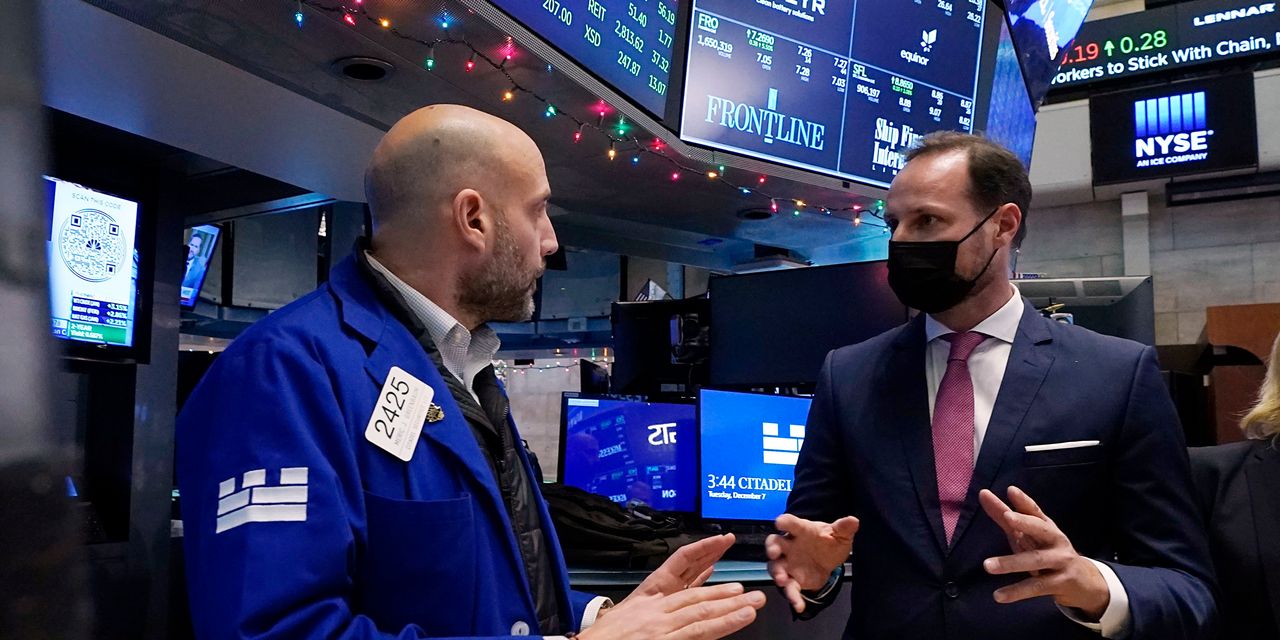U.S. stock futures rose and Treasury yields slipped as investors assessed the uncertain effects of the Omicron variant on the economy.
Futures the S&P 500 gained 0.5% Wednesday, a day after the benchmark index posted its biggest one-day jump since March and closed just shy of an all-time high. Contracts for the Dow Jones Industrial Average also rose 0.5% and futures for the Nasdaq-100 added 0.6%, pointing to a strong start to the session for technology stocks.
Vaccine makers Moderna and
fell 3.8% and 2.6% respectively in premarket trading. Pfizer and BioNTech said Wednesday a third dose of their Covid-19 vaccine neutralized Omicron in lab tests, but that a two-dose regimen was much less effective.
In Hong Kong, China Evergrande shares skidded 5.5% to their lowest level since the embattled property company’s initial public offering in 2009. Evergrande didn’t make the payments due on some U.S. dollar bonds before a final deadline expired Monday, potentially setting the stage for a massive default. Hong Kong’s broader Hang Seng Index edged up less than 0.1%.
Elsewhere, stocks have snapped back after swooning when the Omicron variant first emerged in late November. Investors have pointed to evidence that Omicron might cause less severe illness than previous variants, though scientists are still assessing its virulence and ability to evade vaccines.
“The markets generally—if you look back in 2021—they have looked through any of the episodes of even partial lockdowns or that kind of risk,” said
Willem Sels,
chief investment officer for private banking and wealth at
HSBC.
“They assume vaccines would be effective or partially effective.”
Mr. Sels expects more volatility. “I think we’re going to get a lot of flip-flopping,” he said, pointing to an uncertain outlook for inflation and the potential for mixed economic data next year.

Stocks have snapped back after swooning when the Omicron variant first emerged.
Photo:
Richard Drew/Associated Press
Global markets got another boost this week from Beijing’s moves to stimulate the slowing Chinese economy. Investors remain on edge, however, about the Federal Reserve’s plans to tighten monetary policy to tap the brakes on inflation in 2022.
One reason why some investors expect inflation to persist is the tight labor market. More evidence of hiring difficulties is expected to emerge with the U.S. job openings and labor-turnover survey, due at 10 a.m. ET. Economists forecast that the data will show employers had more than 10 million unfilled positions in October.
In one sign of caution among investors, the yield on 10-year Treasury notes slipped to 1.464% Wednesday from 1.479% Tuesday. Bond yields and prices move in opposite directions.
Oil prices extended a recent rally, driven in part by expectations that the Organization of the Petroleum Exporting Countries and its allies could slow the pace of output growth in January. Benchmark U.S. crude futures rose 0.8% to $72.68 a barrel ahead of data on domestic oil supplies at 10:30 a.m.
European natural-gas prices rose more than 6% after news reports that Nord Stream 2 could be shut down if Russia invades Ukraine. The controversial pipeline linking Russia and Germany had been expected to start operations in 2022, helping to ease Europe’s gas shortage.
International stock markets were broadly higher. The pan-continental Stoxx Europe 600 index rose 0.3%, led by healthcare, travel and leisure stocks. German food-delivery firm
fell more than 6% after issuing earnings guidance for 2022 that fell short of analysts’ expectations.
China’s Shanghai Composite Index rose 1.2%, Japan’s Nikkei 225 1.4% and India’s
S&P Sensex 1.8%.
Write to Joe Wallace at Joe.Wallace@wsj.com
Copyright ©2021 Dow Jones & Company, Inc. All Rights Reserved. 87990cbe856818d5eddac44c7b1cdeb8
